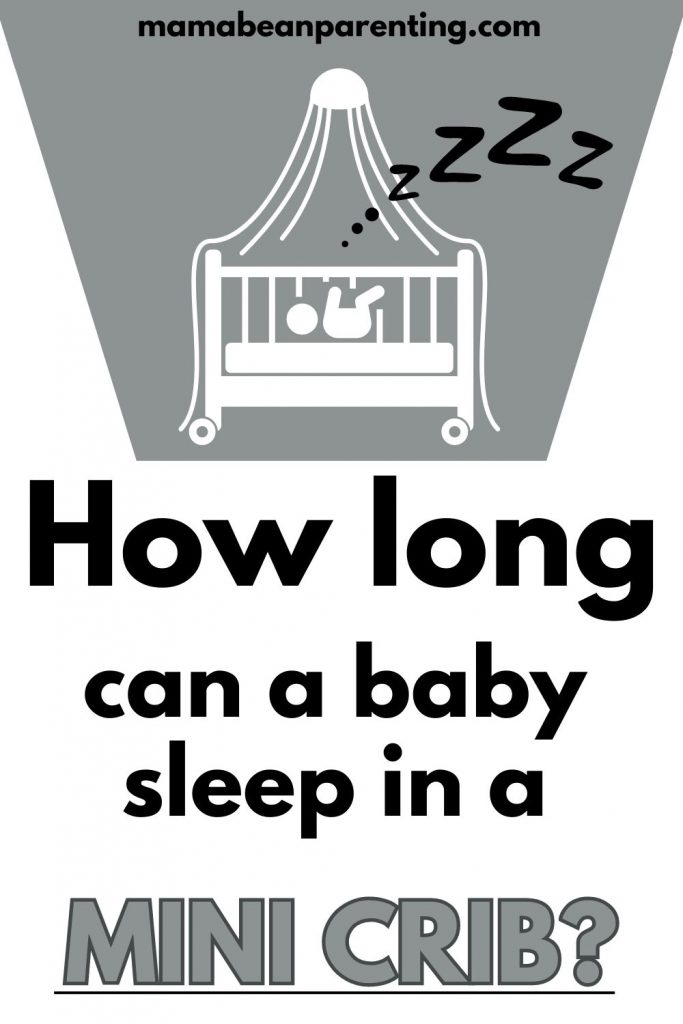Are you excited about your new mini crib or thinking about getting one for your baby?
If so, you likely have many questions about their safety and functionality.
Luckily, we’re here to provide all the answers you need. Parents have many questions, but one that sticks out like a sore thumb is: how long can a baby sleep in a mini crib?
It’s smaller, so indeed, the transition has to happen sooner, right? You would be correct, but there’s a lot of ground that we need to cover.
Maybe you still haven’t decided between a traditional crib and a mini crib. Either way, this in-depth guide aims to address all your concerns.
Mini cribs have a lot to offer, but there are some drawbacks to take into account, as well. So, before you decide, we want to give you all the information you need.
While mini cribs may be small, it’s a big world to explore. So, let’s dive right in.
Why Parents Love the Mini Crib
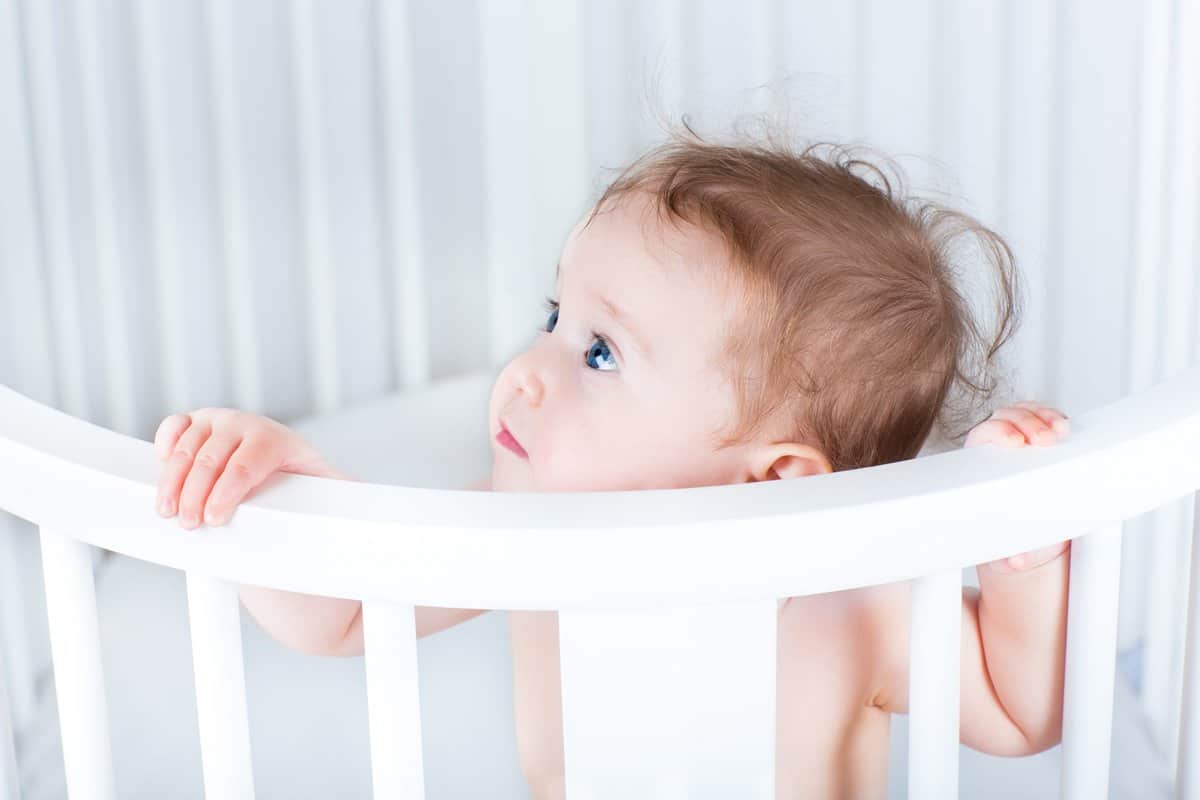
When you’re pregnant, everything feels beautiful and meaningful.
Decorating the nursery room, designing it, and planning every cute little detail are some of the most beautiful memories for a parent-to-be. It’s a blissful experience.
Still, making sure that it all clicks together takes a lot of brainwork.
There are a lot of decisions that have to be made as you prepare for your baby. One of those decisions is choosing between a traditional crib and a mini crib.
If you’re here, it likely means that you have your eyes set on a mini crib – and that’s great. There are a variety of reasons why mini cribs are so popular nowadays. Let’s explore them.
Why do parents love the mini crib?
Well, they’re an excellent space-saving option – hence the name.
Mini cribs are smaller in size, which is great for parents living in smaller homes. Due to their size, the extra convenience can be a real lifesaver. They’re easy to move around.
Their portability comes in handy for parents struggling to manage space. Their compact size and weight can make a world of difference.
They fit neatly into small spaces, but is their size the only benefit? While it’s the main feature and reason parents love the mini crib, it’s not the only one.
The best mini cribs come equipped with loads of versatility features. This is very important, especially if you’re wondering how long can a baby sleep in a mini crib.
The right mini crib can easily last up to the point where your baby transitions to a toddler bed. But, you still have to make sure that your mini crib of choice has versatility options.
It may not have crossed your mind, but mini cribs are actually an ideal choice for parents that love to travel. They’re a viable option for you to organize your family adventures.
If you enjoy hitting the open road with your baby in tow, look no further than a mini crib.
And let’s not forget to mention that mini cribs are so much more affordable.
For parents on a budget, it’s a great option. You’re saving money without compromising your baby’s safety. So, why isn’t everyone using mini cribs? Are there any risks involved?
Well, there are some things that parents have to keep in mind.
Before we dive into the drawbacks, let’s summarize the benefits of mini cribs:
1. They save space, which is their main selling point.
2. They are portable and easy to move around.
3. They are lightweight and great for travel.
4. They are versatile and adjustable.
5. They are more affordable.
Cons of Using a Mini Crib

Mini cribs can be a great choice, but they come with limitations.
Before making a final decision, it’s important to analyze both sides of the coin.
So, what drawbacks do you have to keep in mind?
Well, the first thing that comes to mind is the weight limit. While traditional cribs can typically hold more weight, mini cribs may not be able to withstand the same amount.
Most mini cribs can hold up to 50 pounds, while traditional cribs can do double the amount. So, if your baby is on the larger side, they may outgrow the crib much sooner.
If you do decide to get a mini crib, keep an eye on your baby’s weight.
Make sure that your little one doesn’t exceed the crib’s weight limit. Remember to take into account any items placed inside the crib, such as toys or blankets, when calculating.
Exceeding the weight limit puts your baby in danger. So, keep track of your little one’s weight and avoid placing any items inside the crib. They pose a safety hazard.
Besides weight restrictions, there’s also the matter of durability.
Even the best mini cribs must take shortcuts to ensure a compact design. As a result, they may not be as sturdy as traditional cribs, despite their many other benefits.
Due to their lighter weight, they are more prone to tipping and moving around. Especially when your child gets a little bit bigger, you must take extra steps to ensure stability.
Most of this is just common sense.
It goes without saying that you should never position a mini crib, or any crib for that matter, on uneven ground. If the crib has wheels, make sure that they’re safely secured.
That said, the best mini cribs can be made of pretty tough materials. In reality, you don’t have to worry too much about the mini crib’s durability, but it’s crucial to acknowledge it.
Now, another thing worth noting is that mini cribs generally have less storage space.
That’s the point, after all. Mini cribs are specifically designed to save space.
While the smaller size of a mini crib does save space, it still limits your baby’s mobility.
As your baby grows, moving around and playing inside the crib may be hard. This can branch into other problems, such as an inability to fall asleep due to discomfort.
If so, you may have to transition to a traditional crib sooner rather than later.
Despite these drawbacks, the mini crib remains a viable alternative to the traditional crib.
In some aspects, it’s even better, but you have to consider the full picture.
It’s your decision to make. Just remember to do your research before making a purchase. That said, let’s take one more look at all the drawbacks of a mini crib:
1. They have a smaller weight limit.
2. They tend to be less durable.
3. They have less storage space.
4. They can be uncomfortable.
5. They offer less space for play.
How Long Can a Baby Sleep in a Mini Crib?

Well, here’s the thing: there’s no strict policy for how long a baby can sleep in a mini crib.
Why?
Because it varies from one baby to another.
How long until your baby outgrows it?
The best mini cribs can last until your baby is ready to transition to a toddler bed, usually around two or three years old. Still, some babies may outgrow them sooner than that.
If you’re going for a mini crib, monitor your baby’s development closely.
Keep track of your little one’s height and weight.
One of the most common reasons why babies outgrow the mini crib is that they get too tall too soon. If your baby doesn’t have enough space to move around, it’s an issue.
On the other hand, if your baby is a little bit bigger, it may surpass the weight limit of the mini crib. So, you have to consider both factors and monitor them closely.
The mini crib vs. crib dilemma is a common issue, but it really comes down to personal preference. No matter your decision, you want to ensure your baby’s safety and comfort.
There’s no sure-fire way to know how your baby will react to cribs. So, be present and be observant. Keep an eye on your baby’s development and be willing to adjust if necessary.
Signs That It Isn’t Working Out
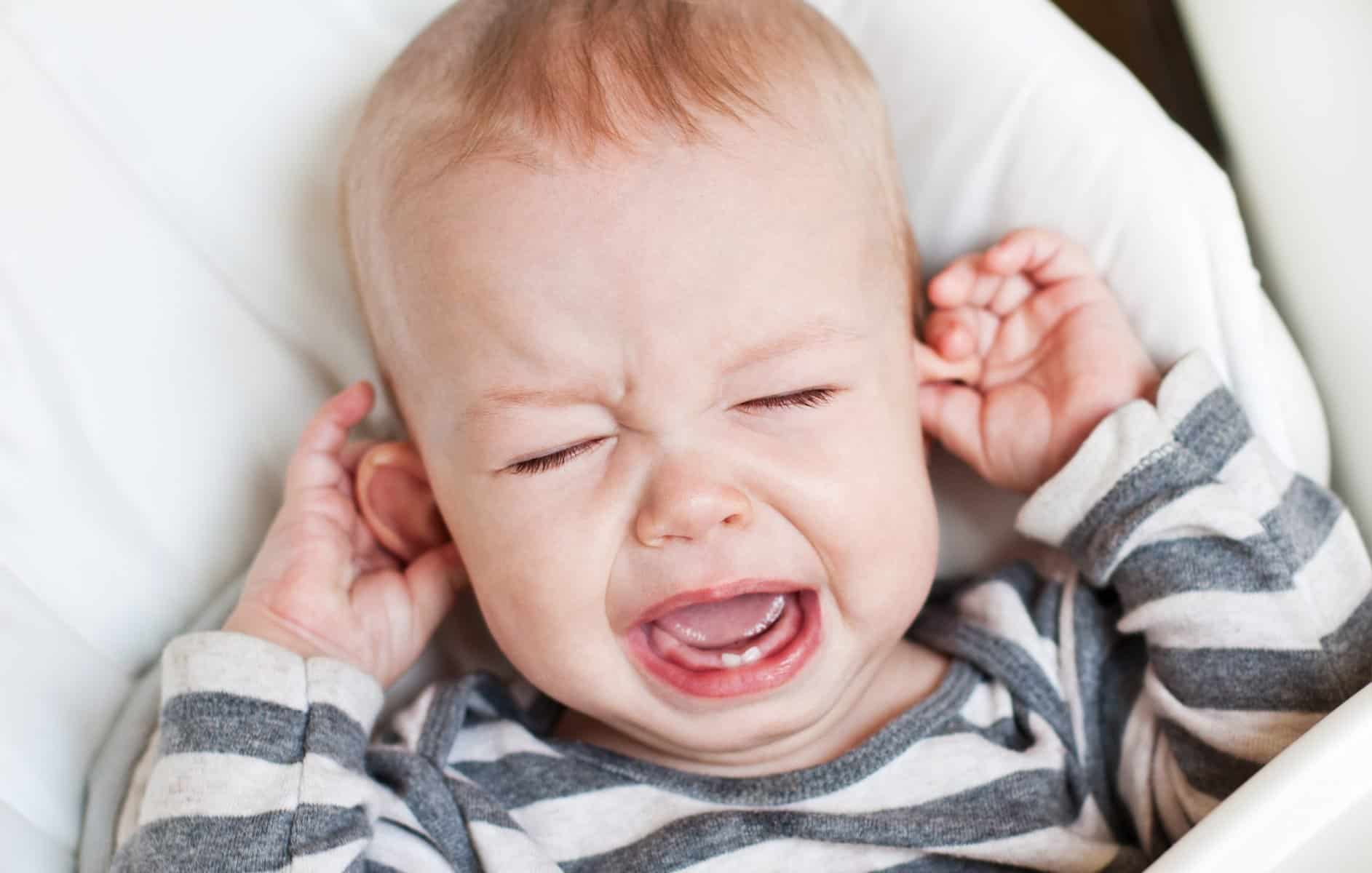
So, what if you invest in a mini crib, but it turns out your little one isn’t a fan?
The good news is that there are many telltale signs your baby doesn’t like it.
Of course, the most obvious sign is your baby’s discomfort.
Cribs don’t offer equal room for sleeping and playing.
With less space in a crib, your baby may become fussier as it might feel more confined. Your baby might even be awake but not crying to express their discomfort.
If your little one doesn’t like the crib, it can seriously affect their sleeping patterns. When a baby finds it hard to sleep, it’s important to identify the underlying cause.
Your baby needs to feel safe and comfortable inside the crib in order to sleep well.
Make sure to investigate the problem thoroughly because the issue may not be with the crib at all. Maybe it’s the size, but it could be the mattress or something else entirely.
Be persistent until you discover the root of the issue.
Your baby might also protest in the crib because they have surpassed its limits.
As discussed earlier, mini cribs have their height and weight restrictions. If exceeded, the mini crib becomes uncomfortable and potentially dangerous for your baby.
In that case, you must transition your baby to a crib alternative.
If they’re not 2 years old yet, transitioning to a regular crib rather than a toddler bed might be a good idea. Yes, this might set you back financially, but it must be done.
A crib can usually last long, but that’s not always true.
Don’t forget to consider your personal needs and preferences as a parent. You’ve likely picked the mini crib because it saves space, but switching when you have to is okay.
If it doesn’t meet your expectations and if you’re unhappy with it, don’t hesitate to switch to a standard crib or another crib alternative, such as a bassinet or even a co-sleeper.
But what if it isn’t the crib making your baby uncomfortable?
Maybe it’s not the size of the mini crib that’s actually causing it.
Here’s how you can create a pleasant sleeping environment for your baby.
Tips for a Safe and Comfortable Sleep

Getting babies to sleep soundly isn’t just about picking the right crib.
You must go the extra length to ensure everything is nice, safe, and comfy.
When it comes to babies, the first few months are always a pain. As you go through sleepless nights, it’s important to do everything properly, even if the results don’t show.
That means being consistent with your baby’s sleep schedule. That’s priority number one.
Consistency is what matters most if you want to make sure that your baby sleeps well.
When you set up your mini crib, don’t overdo it with toys, blankets, bedding, pillows, or any kind of unnecessary items because they could potentially endanger your baby.
Cribs should be kept free of any clutter, no matter the size.
Especially during the first 6 months, you have to take extra steps to ensure your baby’s safety in the crib due to the ever-present risk of SIDS (Sudden Infant Death Syndrome).
You also want to make sure to use a smooth, firm crib mattress, as well as a tight-fitting sheet. But, the most important thing of all is to position the baby safely on their back.
Remember: the mattress has to fit the crib properly.
Take every precaution in order to keep your little one safe and comfortable.
Now, you need to monitor your baby’s temperature. Is the room too hot or too cold? Have you dressed your baby appropriately? Babies find it harder to regulate temperature.
If your baby is too cold or overheating during the night, they may find it incredibly more difficult to rest and sleep, and may cause you more than a single night of sleeplessness.
Even the best mini crib can become unsafe if you don’t position it correctly. So, don’t place it near windows or any kind of potentially hazardous items, such as cords.
Keep it away from bookcases to prevent objects from potentially falling on your baby.
Both standard cribs and mini cribs have to be regularly checked for damage. Inspect the crib regularly for missing screws, bolts and wear and tear. Keep the crib clean, too.
There’s a lot to keep in mind, but one extra tip that could do you good is to incorporate relaxing bedtime activities into your baby’s routine, such as bath time or reading books.
Doing this allows your baby to predict when it’s time for bed. It also calms and soothes your baby, ensuring they fall asleep comfortably as soon you signal time for bed.
And don’t forget to dim the lights and minimize sounds inside your home.
Do all of this well, and we guarantee that your baby will sleep much better.
However, if your baby still finds it difficult to get their rest in a mini crib, then you may want to consider two things. One, it could potentially indicate that your baby is sick.
If that’s not the case, it may just be down to the crib, after all.
So, how do you transition to an alternative?
How to Make the Transition
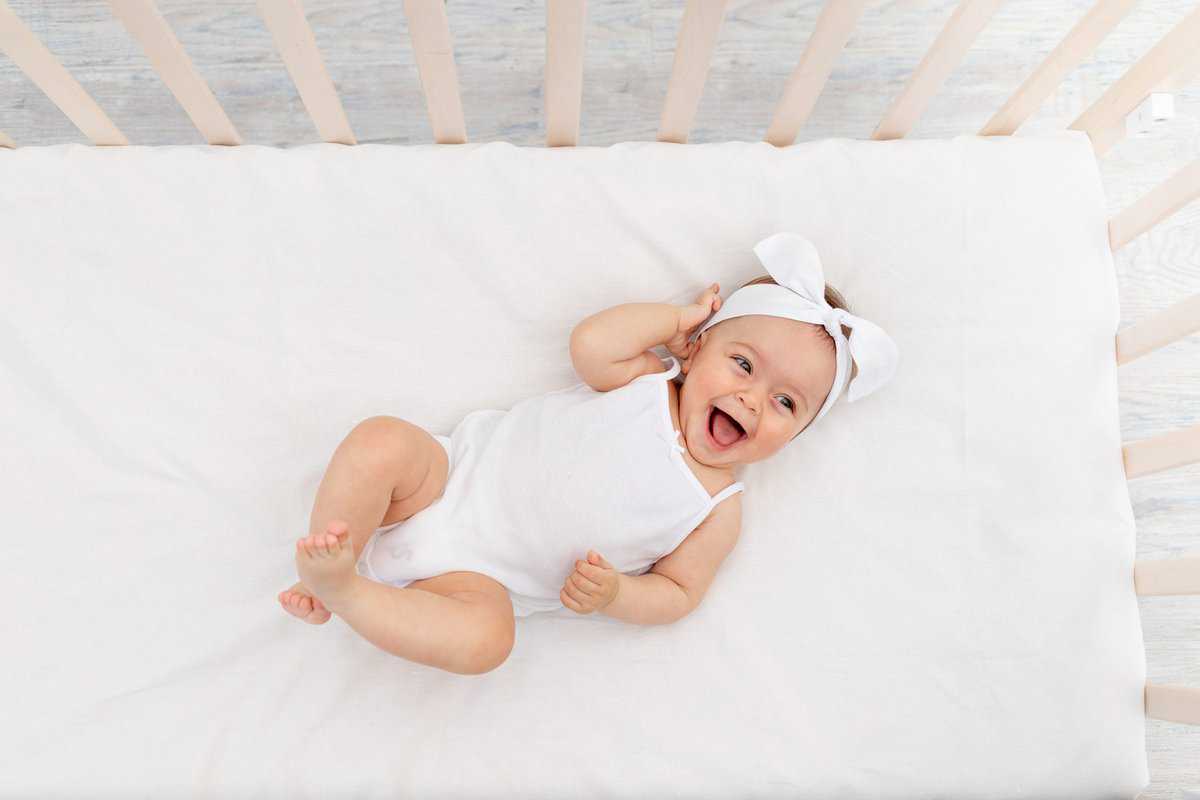
Do you feel it’s necessary to transition to a standard crib? Don’t worry. Making this transition isn’t that hard in the long run, but there are a few things to remember.
First, you must establish thoroughly that your baby is ready. So, we will assume that your little one is at a stage where they need to switch to the standard crib.
When introducing a change as significant as this one, making it familiar is key.
Doing this makes the transition smoother for your baby.
If you don’t have to, don’t relocate the crib. Placing the new standard crib in the same room as the previous mini crib can help create a positive sense of familiarity.
Use your baby’s favorite toys in the new crib during playtime and add sheets and other items that they’re already familiar with to minimize any discomfort or anxiety.
Most of all, however, it’s important to approach the transition gradually.
If your baby is finding it hard to switch from the old crib, start with shorter sessions. With every new day, increase the amount of time they spend inside it until they get used to it.
Above all else, keep your baby safe. Just like you did with the previous crib, you want to go the extra length to ensure your little one’s safety by inspecting everything in the crib.
Things that warrant a closer inspection include the crib’s structural integrity and the mattress. The crib mattress has to fit snuggly in order to prevent any unnecessary risks.
The mattress should have no gaps or spaces around the edges.
Otherwise, your baby can get stuck between the mattress and the crib frame.
Even if you do everything right, things may not work out initially.
This is a big change for your little angel; you must be patient.
But, with effort and consistency, you can get your baby used to the regular crib in no time.
So, here’s what you need to remember:
- Make the new crib familiar to your baby.
- Include your baby’s favorite items.
- Place the new crib in the same place as the old one.
- Transition gradually.
- Inspect the crib before using it.
- Be patient.
How to Switch to a Toddler Bed
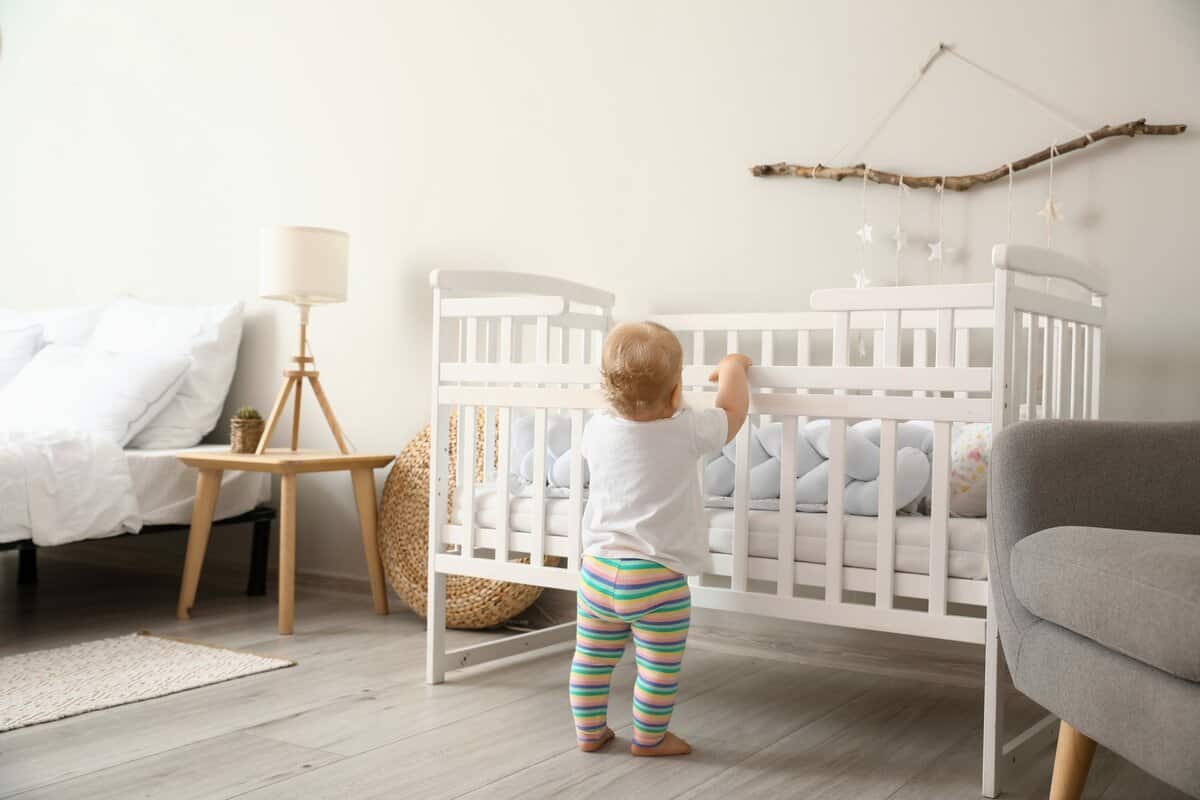
When your little one outgrows the regular crib, it’s time to switch to a toddler bed.
It does not matter how long a baby can sleep in a crib, but how long until they outgrow it.
Of course, the best way to do that is to ensure that your baby is ready. Even though a 2 to 3 years old child is ready for this kind of transition, it varies from one baby to another.
If you’re sure it’s the right time, you must choose the right bed.
There’s a variety of toddler beds to pick from, but you also have the option of preparing in advance by purchasing either a convertible standard crib or a convertible mini crib.
Remember to introduce the toddler bed gradually and make it fun for your baby.
Some babies have a harder time transitioning, but you can make it work with enough effort and persistence. Keep in mind that adding familiar items can help your baby adjust.
Even though you’re switching to a new bed, setting boundaries right from the get-go is essential. You want the transition to go smoothly, but you also want to set ground rules.
As always, take everything into account. Your child may be slightly older, but they still rely on you to keep them safe. So, prioritize the safe use of their new sleeping environment.
It can be a stressful experience when you’re making these types of changes, but with the right kind of preparation and a little bit of patience on your end, it all works out great.
In Conclusion

Standard cribs are great in their own right, but if you want a smaller-sized crib to save on space or to travel, a mini crib might be the perfect solution, despite its few limitations.
The mini crib vs crib dilemma is common, and it can be difficult for parents to make. Remember to consider your needs, budget, and preferences before purchasing.
Keep in mind that due to its smaller size, a mini crib has weight and height restrictions.
This means that you have to do your research carefully first.
Even the best mini crib may not be suitable for all babies.
If you’re worried about how long a mini crib can last, it’s hard to say. It depends on your child’s growth rate. It’s possible for them to outgrow the mini crib sooner than expected.
There’s nothing wrong with standard cribs, but the size of the crib matters.
If you want to have all the comfort of a standard crib without it taking up too much space – the mini crib is the way to go. You may also want to consider a convertible mini crib.
Using the best mini crib doesn’t guarantee good results. So, feel free to refer to our tips for safe and comfortable sleep. It takes time for a baby to adjust to a small-sized crib.
You have to take many things into account, including the mattress and the sheets.
It’s not about standard or mini cribs – but about keeping your baby safe and helping them get a good night’s rest. No matter the size of the crib, you have to take safety measures.
Since it’s difficult to predict how long a baby can sleep in a mini crib because it’s different for every baby, it’s better to focus on being observant and making a switch if necessary.
Use the information we’ve provided to make a well-informed decision.
There are no such things as the best mini crib that guarantees long or indefinite usage. So, it’s important to practice patience, be prepared, and make transitions when necessary.

Mother of three and a primary school teacher. I’ve always loved being around children and helping them, so I chose my path as a teacher. It is sometimes hectic with three children, but I am 100 percent into it and wouldn’t change it for anything in the world.


